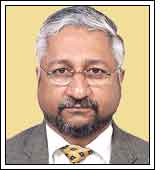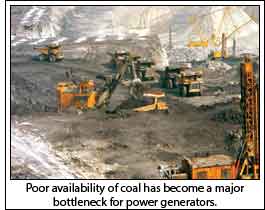
The country's
economic growth
depends purely on the
growth of power
sector; stronger the
growth in power sector
stronger is the growth
in the economy.
Prakash Nayak,
Chairman—Power
Panel, Institution of
Engineering and
Technology and also
Director—
Microgrid,
India Smart Grid
Forum, explains the
core issues hindering
the growth of the
power sector in India.
The country's economic
growth depends purely on
the growth of power sector;
stronger the growth in
power sector stronger is the
growth in the economy. The problems
in the power sector are multifarious,
relating to fuel shortages,
lack of adequate finance, poor
financial health of distribution
utilities, absence of cost-reflective
tariffs and peak demand shortages
and non-availability of competent
technical, skilled and project
management resources. In
addition, land acquisition right of
way and environmental clearances
are the added hindrances to
the investments and project execution.
Fuel crisis: Fuel availability,
mainly coal and gas, has emerged
as a severe bottleneck for power
generators. Though we have large
coal reserves, coal production in
the country is growing only at the
rate of 5 per cent when the power
sector growth of 10-15 per cent in
the last Five-Year Plan, thus leading
to acute coal shortages. Availability
of good quality coal- during
the current financial year 2011-
12, the anticipated gap between
the requirement and availability
of domestic coal was estimated
around 54 million tonnes. Out of
54 million tonnes, 35 million
tonnes of coal was to be met
through import of coal. The availability
of natural gas has been a
concern for many years and liquefied
natural gas is thrice as expensive.
T&D losses: Energy generated
in the supply chain is lost to the
extent of 30 to 40 per cent. Though
it varies from state to state and
some states are better, it is in no
way comparable to world's best in
South Korea where it is close to 4
per cent. What is also worrying is
billing inefficiency on top of it.
This is one reason the state utilities
are becoming financially
unviable and are deteriorating
and not able to support the investment
in both capacity expansion
and operational improvement.
The massive black out in July this
year is an early warning to all concerned,
we need better systems
and operation. The requirement
and complexity and challenges in
the Indian power sector cannot be
compared with that in the West.
Thus what is needed a solution
from within and we have enough
knowledge experts and thinktanks
in India.
 Financial status:
Financial status: The gap
between the power purchase costs
and the power tariffs has severely
constrained the finances of state
power utilities with net losses estimated
at around

88,170 crore in
2012-13 (Thirteenth Finance
Commission Report) and close to
1 per cent of India's GDP is probably
the most critical challenge
faced by the sector. The losses on
account of outstanding loans, low
tariffs, rising power purchase
costs and subsidizing power and
also AT&C losses thus making
them economically not viable.
Most of the banks are reaching
their power sector exposure limits.
Though there is permission to
invest 100 per cent equity, foreign
investors are taking a cautious
approach and are deterred by the
complexities of the power sector.
Thus the funding gap in the current
plan period alone estimated
at

4 trillion financing has become
constrained for the sector. This
involves distribution and transmission.
Cash losses booked by various
state distribution companies have
increased significantly over the
last few years, posing a risk of payment
delays and/or defaults to the
power producers. Investors find
comfort in the fact that in several
states, a significant portion of the
SEB loans are backed by guarantees
by the state governments.
However, the fiscal health of several
states is questionable so guarantees
may prove inadequate in
the event of a crisis.
Deficits: In many states, industries
are facing up to 50 per cent
percent power cuts. (CEA Monthly
Highlights of Power Sector-
July2012) and demand supply
gap is close to 9per cent. The peak
demand and supply gap today
stands around 10 per cent and is
expected to increase in the next
few years. These issues need to be
addressed by focusing on improving
the loss situation in the country
as primary focus and capacity
building as second focus area.
Demand side management and
focus on renewable energy and
microgrid are possible solution;
however, this needs larger thrust
from policy makers. Solar PV
panels with remote, off-grid
microgrids will drive rapid growth
of distributed renewable energy
(DRE) in rural and remote areas
greater numbers of communities,
agricultural areas small businesses,
hospitals, schools & colleges
etc. Thus, one can have access to
cleaner, more reliable, and more
efficient energy generation and
the potential to empower millions
to improve their lives and living
conditions. Growing adoption
and spread of DRE technology
and smart microgrids might eliminate
diesel generation and also
help in bridging the gaps. According
to a forecast from Pike
Research, solar is now cheaper
than diesel in India and a primary
driver for remote Microgrids over
the next years will be the integration
of solar PV, a technology that
will help reduce fossil fuel consumption
to some extent, though
our dependencies cannot be ruled
out.
 Manpower:
Manpower: Availability of competent
engineering and skilled
resources is a major area of concern
in India, particularly considering
the 200 GW of new power
generation capacity envisaged in
the next ten years. To cope up with
this demand and further looking
at employability of engineers and
technicians that is as low as 30 per
cent yet, another issue in terms of
availability of competent
resources adds to the issues in
power sector growth. Certain
competences like certified project
managers are not available in
abundance to meet the demands.
This is directly affecting the project
execution and thereby cost
overrun. If one takes of survey of
10 projects and try to pick up the
project execution status of various
projects in the country, I am sure
more than 75 per cent of projects
are delayed and more than 50 per
cent of them are delayed on
account of skill shortage it applies
to private as well as government
projects, worst in the government
sponsored projects.
A project professional must have
qualifications and competency
framework to execute projects and
programs like any other profession.
Out of the approximately
39,000 Certified Project Managers
(CPM) globally, 43 per cent
are in China (about 17,000). In
India we have only 96 out of
39,000 CPMs. China has recognized
the need of qualifications
and competency amongst their
project professionals. India needs
to address this as well.
Prakash Nayak is Chairman-Power Panel, Institution of
Engineering and Technology, and also Director-Microgrid,
India Smart Grid Forum